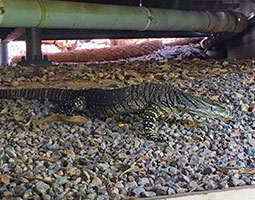Varanus varius
Description

The Lace Monitor (Varanus varius) is found along the east coast of Australia in forests and coastal woodlands. Typically they grow to a length of 1.5 - 2m and although their colouration varies, they are mostly a very dark grey highlighted with yellow to cream spots and stripes.
These large lizards spend a large amount of time in the trees but must return to the ground to forage for food. Lace Monitors are very good at smelling carrion (dead animals) which they will readily feed upon particularly near roads where road kills are plentiful.
Lace Monitors can become very comfortable in urban environments where they will scavenge rubbish bins for food and even take food from picnic tables or directly from the hands of people.
Adaptations
- After a large feed they are able to go for many weeks without feeding again.
- Lay between 6 to 12 eggs each year usually in termite mounds, particularly those found in trees
- The toes are equipped with very long claws that are well adapted for climbing
- Monitors have a forked tongue just like snakes used for tasting scents in the air
Feeding relationships
- What I eat: Birds, insects, bird eggs, reptiles and small mammals
- What eats me: Birds (Kookaburra, Butcher Birds), large lizards like water dragons and other Lace monitors, domestic cats, large snakes (Juveniles only).
Interesting facts
Once the female lays the eggs in a termite nest, she then leaves the termites to reseal the eggs inside the nest. The mother is aware of when the eggs are due to hatch and she will return to the nest and open it up to allow the juveniles to escape.